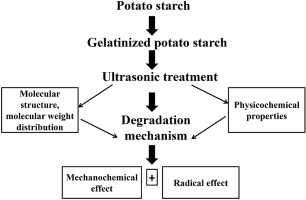当前位置:
X-MOL 学术
›
Food Hydrocoll.
›
论文详情
Our official English website, www.x-mol.net, welcomes your feedback! (Note: you will need to create a separate account there.)
Retrogradation, gel texture properties, intrinsic viscosity and degradation mechanism of potato starch paste under ultrasonic irradiation
Food Hydrocolloids ( IF 10.7 ) Pub Date : 2019-10-01 , DOI: 10.1016/j.foodhyd.2017.08.035 Hui Nie , Chen Li , Pei-Hua Liu , Cai-Yu Lei , Jian-Bin Li
Food Hydrocolloids ( IF 10.7 ) Pub Date : 2019-10-01 , DOI: 10.1016/j.foodhyd.2017.08.035 Hui Nie , Chen Li , Pei-Hua Liu , Cai-Yu Lei , Jian-Bin Li

|
The effects of sonication on the retrogradation, gel texture properties, intrinsic viscosity and degradation of potato starch paste (PSP) were investigated using a specially designed reactor to study changes in molecular structure and functional properties. The retrogradation was analyzed by an x-ray diffractometry. The gel texture properties were analyzed by texture profile analysis (TPA) and the intrinsic viscosity was analyzed using a Cannon-Ubbelohde viscometer at different sonication times, intensities and PSP concentrations. The molecular weight of PSP was determined using gel permeation chromatography (GPC). The results showed that retrogradation of PSP occurred when it was placed in a high density ultrasonic field, and was accompanied by a transition from crystalline type B to type VH. The TPA results indicated remarkable decreases in gel texture properties (hardness, fracture ability, adhesiveness, gumminess, and chewiness) when the sonication time was prolonged, the intensity was increased and when the PSP concentration was reduced. Intrinsic viscosity decreased with extended sonication time and at higher intensity, but increased as the PSP concentration increased. The GPC results showed that the average molecular weight of PSP decreased significantly upon ultrasonic irradiation and the sample had a narrower distribution of molecular weight. The degradation kinetics were adequately described by the Baramboim models. Radical trapping by 2,2-diphenylpicrylhydrazyl was used to assess the radical-attack mechanism in PSP subjected to ultrasound. Under the reaction conditions, degradation of PSP in the ultrasound field is caused by OH radicals and mechanochemical effects. Mechanochemical effects were the main cause of bond scission.
中文翻译:

超声辐照马铃薯淀粉糊的回生、凝胶质构特性、特性粘度及降解机理
使用专门设计的反应器研究了超声处理对马铃薯淀粉糊 (PSP) 的回生、凝胶质地特性、特性粘度和降解的影响,以研究分子结构和功能特性的变化。通过X射线衍射法分析回生。通过质地剖面分析 (TPA) 分析凝胶质地特性,并使用 Cannon-Ubbelohde 粘度计在不同的超声处理时间、强度和 PSP 浓度下分析特性粘度。使用凝胶渗透色谱法 (GPC) 测定 PSP 的分子量。结果表明,PSP在高密度超声场中发生回生,并伴随结晶B型向VH型转变。TPA 结果表明,当超声处理时间延长、强度增加和 PSP 浓度降低时,凝胶质地特性(硬度、断裂能力、粘附性、粘性和咀嚼性)显着下降。特性粘度随着超声处理时间的延长和强度的增加而降低,但随着 PSP 浓度的增加而增加。GPC 结果表明,超声辐照后 PSP 的平均分子量显着降低,样品的分子量分布更窄。Baramboim 模型充分描述了降解动力学。2,2-二苯基苦基肼的自由基捕获被用来评估超声处理 PSP 中的自由基攻击机制。在反应条件下,PSP 在超声场中的降解是由 OH 自由基和机械化学效应引起的。机械化学效应是键断裂的主要原因。
更新日期:2019-10-01
中文翻译:

超声辐照马铃薯淀粉糊的回生、凝胶质构特性、特性粘度及降解机理
使用专门设计的反应器研究了超声处理对马铃薯淀粉糊 (PSP) 的回生、凝胶质地特性、特性粘度和降解的影响,以研究分子结构和功能特性的变化。通过X射线衍射法分析回生。通过质地剖面分析 (TPA) 分析凝胶质地特性,并使用 Cannon-Ubbelohde 粘度计在不同的超声处理时间、强度和 PSP 浓度下分析特性粘度。使用凝胶渗透色谱法 (GPC) 测定 PSP 的分子量。结果表明,PSP在高密度超声场中发生回生,并伴随结晶B型向VH型转变。TPA 结果表明,当超声处理时间延长、强度增加和 PSP 浓度降低时,凝胶质地特性(硬度、断裂能力、粘附性、粘性和咀嚼性)显着下降。特性粘度随着超声处理时间的延长和强度的增加而降低,但随着 PSP 浓度的增加而增加。GPC 结果表明,超声辐照后 PSP 的平均分子量显着降低,样品的分子量分布更窄。Baramboim 模型充分描述了降解动力学。2,2-二苯基苦基肼的自由基捕获被用来评估超声处理 PSP 中的自由基攻击机制。在反应条件下,PSP 在超声场中的降解是由 OH 自由基和机械化学效应引起的。机械化学效应是键断裂的主要原因。


























 京公网安备 11010802027423号
京公网安备 11010802027423号